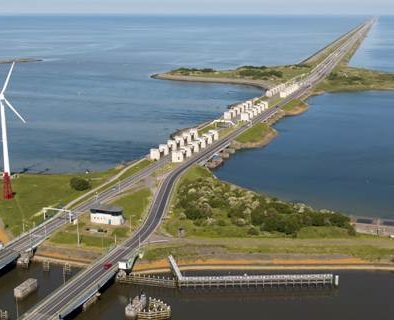Rijkswaterstaat intends to award the reinforcement of the Afsluitdijk and increasing the water discharge capacity to Levvel bv (currently in formation).
joint venture of BAM PPP PGGM Infrastructure Coöperatie U.A. / Van Oord Aberdeen Infrastructure Partners B.V. / RebelValley B.V. will be responsible for designing, building and pre-financing the project. The consortium will also be responsible for maintenance of the dike for 25 years.
The dike – theAfsluitdijk – is widely regarded as an icon of the Netherlands’ constant struggle against water and an international calling card for the Dutch hydraulic engineering sector.
The Afsluitdijk has been protecting the Netherlands from the sea for more than eighty years – however, the dike no longer meets current flood protection requirements.
The scheme has been developed to address the growing impacts of climate change and ensure the dike is still be able to protect against flooding in the face of rising sea levels and more frequent extreme weather conditions.
Afsluitdijk must meet once-in-ten-thousand-years risk
The Afsluitdijk has to offer protection even in severe weather conditions, for example the coincidence of a spring tide and an extreme north-westerly storm. In that event, the water is driven high against the dike and waves crash over it. The dike must not succumb to that pressure. The Afsluitdijk has to be able to meet the once-in-ten-thousand-years criterion, which means it has to be able to withstand any combination of high water and waves with a risk of occurring once in ten thousand years. In other words, it has to be able to cope with what is known as a ‘superstorm’.
New pumping station expected to be largest in Europe
Rijkswaterstaat is planning to reinforce the Afsluitdijk and make it overflow-resistant by replacing the outer cladding and strengthening the sluices and locks to strengthen the dike along its entire length and reinforce all of its components.
The project will include the installation of powerful pumps in the sluice complex at Den Oever so that more surplus water can be discharged from the IJsselmeer into the Wadden Sea. The Afsluitdijk’s new pumping station is expected to be the largest in Europe.
The pumps at Den Oever will be installed in stages to enable Rijkswaterstaat to respond to the actual pace of the rise in the sea level. This will also allow the organisation to always make use of the latest technologies and provide solutions that remain effective in the longer term. Space will be left so that additional pumps can be installed in the future if necessary. In this way, Rijkswaterstaat said it will be able to maintain the water level in the IJsselmeer at its current height until at least 2050.
The measures will keep the dike safe at least until 2050 and make it relatively easy to adopt additional measures for the ensuing period until 2100.
Construction works are expected to start in the autumn of 2018 with works on the Afsluitdijk due for completion in 2022.
The jv was one of three consortia who submitted their offers in December 2017.
Following the provisional award, which was made known to candidates on 22 February 2018, consortia that have not been awarded the contract will have the opportunity to raise an objection during the next 20 days.
The Afsluitdijk protects large parts of the Netherlands against flooding from the sea and the IJsselmeer since 1932.

